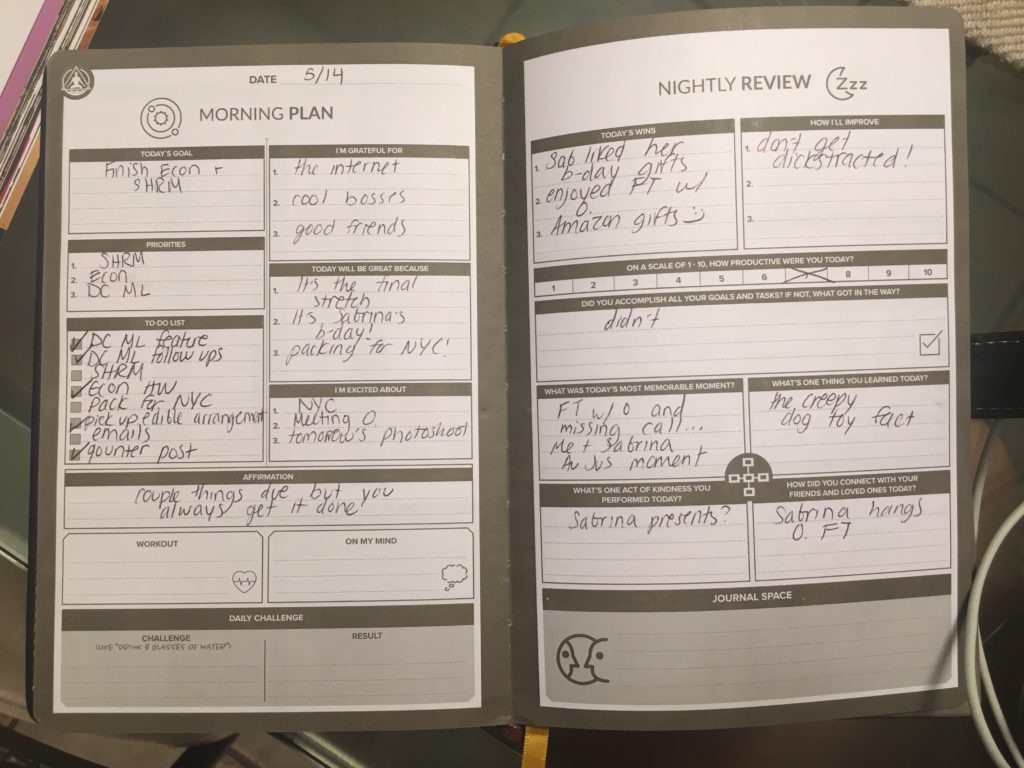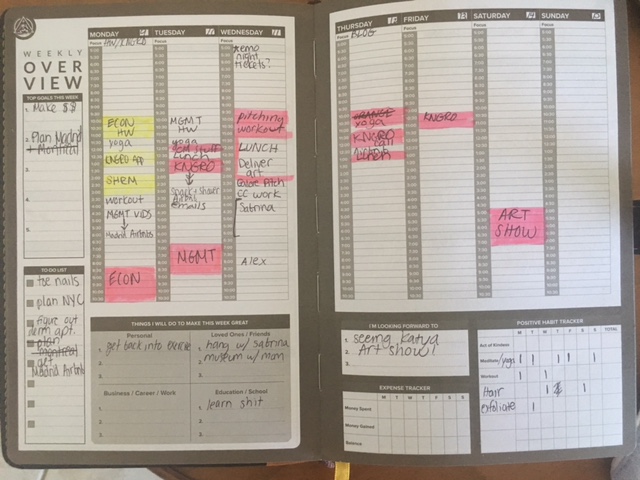If you’ve never been a journal-er but want to learn how to journal effectively (especially if it means boosting productivity), you’ve come to the right place!
Back in my day, we didn’t call them journals, we called them diaries.
They weren’t used for productivity or gratitude, they were fluffy and sparkly, sold at Limited Too, and mainly used to write about your latest crush or backstabbing BFF.
Every time I tried to write in my diary as a tween, I found myself writing in a voice that wasn’t really mine (something every writer can probably relate to). And, I still didn’t feel comfortable being completely honest about everything. After all, what if somebody discovered my diary and my secrets were spilled to everyone?
Fast-forward to 2018, and we’ve traded in our gel pens for moleskin notebooks. Oh, and journaling is a sign of being put together and self-aware. It fits nicely along all the meditation, yoga, and “cleanses” we’ve all been trying to do in search of happiness, mindfulness, and self-fulfillment.
But after trying to journal/diary a zillion times over, I didn’t even bother trying to hop on the repackaged trend. Besides, I write enough as is.
But one planner brand, Transcending Waves, sent me one of their planners back in March, and it completely changed how I felt about journaling. Not to mention, it increased my productivity, helped me keep track of my schedule (even things I wouldn’t normally put on my schedule, like when I washed my hair), made me feel more grateful, and helped me to enjoy my morning routine more.
Most importantly, it helped me learn how to journal effectively.
Okay, I know I sound like I’m a salesperson for their journals or something, but I’m honestly not. Yes, they sent me the original journal, but this post is not sponsored. I honestly didn’t realize how much I appreciated it until I got to the last page of the journal and realized I couldn’t bear the thought of not getting another one immediately (which I purchased with my own $).
So, I figured I’d share some of the ways I’ve used this planner to work for me and how to journal effectively. Of course, you can definitely take these tips to your own journal/planner (it doesn’t have to be Transcending Waves). If you’re a freelancer, have your own business, or work from home, you’ll probably appreciate and relate to this extra.
5 Tips For How To Journal Effectively

1. Make It a Part of Your Morning (And Evening) Routine
If you’ve ever tried meditating, or running, or whatever, you probably know this by now, but it takes 21 days to form a new habit.
I always bring my journal to the breakfast table with me and fill it out while I’m eating my breakfast/drinking tea. It helps me set up my plan for the day and reminds me of anything I have to do that day.
Because the Transcending Waves journal also has a “Nightly Review” section, I try to fill that out as the last thing I do at my desk before shutting down my laptop and heading into bed.
Unfortunately, I still have trouble remembering to fill out the evening portion sometimes (okay, more than sometimes), but I’ve got the morning part down pat.
It’s actually pretty nice starting your day with putting a pen to paper, because I feel like most of us don’t get the opportunity to do that anymore. And, of course, filling out the “I’m grateful for…” and “Today will be great because…” sections help you to start your day in a good mood.
Here’s a pic of what the daily pages look like:


2. Forget The Idea That Anyone Will Ever Read It (Because Trust Me, They Won’t)
As I was flipping through pages to find “good” ones to take photos of for this article, I had a tough ass time. Why? Because I write some ratchet and embarrassing stuff in my planner/gratitude journal sometimes.
Let’s face it, sometimes you really are grateful for getting laid last night, or for the chocolate chip cookie you ate for breakfast that morning, and if that’s the case you should write that shit down!
There were also days where I literally wrote down even the smallest things in my calendar to remind myself to do them — think “put on self tanner” and “take medication.”
Sure, these things might technically be embarrassing if you had to put your journal pages up on a projector in front of your boss, but you will never have to! This isn’t middle school and your arch nemesis is not going to steal your journal out of your locker and photocopy all the pages to distribute across the hallway a la Regina George.
Also, on that note, what you write in your journal literally doesn’t have to make sense to anyone but you! There’s no reason to use full sentences, or write people’s full names. Get weird with it if you want to. In the “affirmation” section for the day I’ve legit written Drake song lyrics.

3. Keep Your To-Do List Realistic & Break Big Tasks Up Into Bite-Sized Pieces
My favorite part of this journal in particular was the to-do list to fill out every day. Previously I’d kept track of my to-do list via the iPhone app or via one long Notes app page I consistently update on my laptop. I still do the Notes page thing, but using the to-do list in the journal helps me to realize what I need to get done that day and makes my “master” to-do list much less daunting.
However, even the eight slots that my journal gives me for the daily to-do list can be too much sometimes, which is why I had to find a balance of what types of tasks to put on my to-do list and how to keep it realistic.
For example, today I knew I wanted to work on a project for my Project Management class (I’m in grad school, fun fact!). Instead of just listing “PM project” on my to-do list, I put “get halfway through PM project.” Other times I’ve written something like, “spend 2 hours on X.”
Not only is this more realistic and will ensure I get to the other things on my to-do list for the day, it also stops me from doing my favorite form of procrastination: avoiding the largest item on my to-do list and completing all the other tasks, then calling it a night before I get to the big task.
I also try to have at least one or two “easy” tasks on my to-do list each day so that when I need my brain needs a break, I can take a rest while still being productive. (examples of tasks: paint toe nails, pick up Rx from CVS, list 10 items on Depop).

4. Try Mono-Tasking
I read some article about increasing productivity in The Washington Post a few months back, and even though I like to think I’m a pretty damn productive person, I took away two key points.
The first point is that you’re the most productive in the morning, no matter if you’re a morning person or not, so start with your hardest task first.
The second point was mono-tasking, and my journal lent itself perfectly to that.
Basically, instead of writing a blog post, answering emails, checking Instagram, and watching a lecture on 10 different tabs intermittently, you pick one task and dedicate a certain amount of time to solely that task.
It sounds basic, but I can guarantee that the majority of us don’t do it.
For example, if I needed to put in some work on a client project, I’ll mark off the time from 2-4 PM in my calendar and just work on that client project. For added effectiveness during these power hours, I’d put my phone on “do not disturb” mode to ensure I didn’t accidentally find myself scrolling through Twitter.
The reason I started doing this was actually because I noticed that I’d be “working” all day, but didn’t feel like I accomplished anything at the end of the day. This was partly because I’d waste time on social media or whatever, but also because I’d jump from task to task and not actually finish any one thing.
Mono-tasking has helped me a ton, and it’s nice looking at my journal and seeing how much I did that day rather than going to bed thinking, “WTF did I do all day?”
Even if you’re not interested in how to journal effectively/journaling in general, you can probably take some value from mono-tasking!
Here’s an example of how I use the weekly overview to try to keep track of what I’m doing at all/most times (and how to journal effectively, of course):


5. Don’t Beat Yourself Up If You Get Off Track
If you flip through my journal, you’d see that there were some weeks where I legit filled out every single box/line, and there were some weeks where I basically only filled out the “to-do list” section each day.
Most of the time, when I was traveling and out of my normal routine, my journaling fell to the wayside. Sometimes I would try to force myself to keep to journaling, but I realized that it’s okay to slack off a little when you’re on vacation or super busy, just like you would slack off on working out or meditating or whatever. This post is about how to journal effectively, and if you’re forcing yourself to scribble BS down while eating vegan tapas in Madrid, it’s probably not effective!
If you’re interested in buying the Transcending Waves journal that I use (and love), you can use the code ASHLEY10 for 10% off yours here. If not, I hope you’ve still found some good journaling tips!
This post was getting super long so I wanted to cut myself off before I wrote a novel, but if you have more questions about how to journal effectively or think I missed something, feel free to comment!

Photos By @henry.ivany




